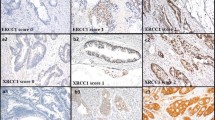Abstract
DNA double-strand breaks (DSB) are severe damages induced by ionizing radiation. Non-homologous end joining (NHEJ) is a major mechanism for repairing DSB. Immunohistochemical analysis of proteins involved in NHEJ, such as Ku86 and XRCC4 (X-ray repair cross-complementing protein 4) may be useful for predicting tumor radiosensitivity. We examined the relationship between expression of DSB-related proteins in biopsy specimens of uterine cervical cancer and the pathological effect of 40 Gy of preoperative radiotherapy. 119 patients with uterine cervical cancer were treated between 2000 and 2011. Pathological effects of preoperative radiotherapy were classified by examining hysterectomy specimens. Patients with complete response (pCR) had a significantly better overall 5-year survival rate than those without pCR (96.3 vs. 76.9 %, P = 0.02). The pCR rate was significantly higher in patients with low Ku86 and XRCC4 expression than in other patients (47.4 vs. 21.3 %, P = 0.04). Logistic regression analysis also demonstrated that low Ku86 and XRCC4 expression was a significant predictor of pCR (P = 0.03). Patients with high Ku86 and XRCC4 expression had a significantly lower 5-year metastasis-free rate than others (79.3 vs. 93.5 %, P = 0.02). Proteins involved with NHEJ might have an influence on results of radiotherapy for uterine cervical cancer.



Similar content being viewed by others
References
NCCN Clinical Practice Guidelines in Oncology—Cervical Cancer v. 2. 2015. National Comprehensive Cancer Network. http://www.nccn.org/professionals/physician_gls/pdf/cervical.pdf (6 July 2015, date last accessed)
Benedetti-Panici P, Greggi S, Colombo A, Amoroso M, Smaniotto D, Giannarelli D, Giannarelli D, Amunni G, Raspagliesi F, Zola P, Mangioni C, Landoni F (2002) Neoadjuvant chemotherapy and radical surgery versus exclusive radiotherapy in locally advanced squamous cell cervical cancer: results from the Italian multicenter randomized study. J Clin Oncol 20:179–188
Chemotherapy Neoadjuvant, for Locally Advanced Cervical Cancer Meta-analysis Collaboration, (2003) Neoadjuvant chemotherapy for locally advanced cervical cancer: a systematic review and meta-analysis of individual patient data from 21 randomised trials. Eur J Cancer 39:2470–2486
Ferrandina G, Gambacorta A, Gallotta V, Smaniotto D, Fagotti A, Tagliaferri L, Foti E, Fanfani F, Autorino R, Scambia G, Valentini V (2014) Chemoradiation with concomitant boosts followed by radical surgery in locally advanced cervical cancer: long-term results of the ROMA-2 prospective phase 2 study. Int J Radiat Oncol Biol Phys 90:778–785
Hall EJ (2006) DNA strand breaks and chromosomal aberrations. In: Hall EJ, Giaccia AM (eds) Radiobiology for the Radiologist, 6th edn. Lippincott Williams & Wilkins, Philadelphia, pp 16–29
Polo SE, Jackson SP (2011) Dynamics of DNA damage response proteins at DNA breaks: a focus on protein modification. Genes Dev 25:409–433
Lees-Miller SP (1996) The DNA-dependent protein kinase, DNA-PK: 10 years and no ends in sight. Biochem Cell Biol 74:503–512
Jeggo PA (1998) Identification of genes involved in repair of DNA double-strand breaks in mammalian cells. Radiat Res 150:S80–S91
Komuro Y, Watanabe T, Hosoi Y, Matsumoto Y, Nakagawa K, Tsuno N, Kazama S, Kitayama J, Suzuki N, Nagawa H (2002) The expression pattern of Ku correlates with tumor radiosensitivity and disease free survival in patients with rectal carcinoma. Cancer 95:1199–1205
Zhao HJ, Hosoi Y, Miyachi H, Ishii K, Yoshida M, Nemoto K, Takai Y, Yamada S, Suzuki N, Ono T (2000) DNA-dependent protein kinase activity correlates with Ku70 expression and radiation sensitivity in esophageal cancer cell lines. Clin Cancer Res 6:1073–1078
Sakata K, Matsumoto Y, Tauchi H, Satoh M, Oouchi A, Nagakura H, Koito K, Hosoi Y, Suzuki N, Komatsu K, Hareyama M (2001) Expression of genes involved in repair of DNA double-strand breaks in normal and tumor tissues. Int J Radiat Oncol Biol Phys 49:161–167
Kamdar RP, Matsumoto Y (2010) Radiation-induced XRCC4 association with chromatin DNA analyzed by biochemical fractionation. J Radiat Res 51:303–313
Japanese Classification of Esophageal Cancer 10th edition. Kanehara & Co., Ltd., Tokyo
Fuller AF Jr, Elliott N, Kosloff C, Hoskins WJ, Lewis JL Jr (1989) Determinants of increased risk for recurrence in patients undergoing radical hysterectomy for stage IB and IIA carcinoma of the cervix. Gynecol Oncol 33:34–39
Alvarez RD, Potter ME, Soong SJ, Gay FL, Hatch KD, Partridge EE, Shingleton HM (1991) Rationale for using pathologic tumor dimensions and nodal status to subclassify surgically treated stage IB cervical cancer patients. Gynecol Oncol 43:108–112
Hayashi J, Sakata K, Someya M, Matsumoto Y, Satoh M, Nakata K, Hori M, Takagi M, Kondoh A, Himi T, Hareyama M (2012) Analysis and results of Ku and XRCC4 expression in hypopharyngeal cancer tissues treated with chemoradiotherapy. Oncol Lett 4:151–155
Niibe Y, Kenjo M, Kazumoto T, Michimoto K, Takayama M, Yamauchi C, Kataoka M, Suzuki K, Ii N, Uno T, Takanaka T, Higuchi K, Yamazaki H, Tokumaru S, Oguchi M, Hayakawa K (2006) Multi-institutional study of radiation therapy for isolated para-aortic lymph node recurrence in uterine cervical carcinoma: 84 subjects of a population of more than 5,000. Int J Radiat Oncol Biol Phys 66:1366–1369
Rotman M, Pajak TF, Choi K, Clery M, Marcial V, Grigsby PW, Cooper J, John M (1995) Prophylactic extended-field irradiation of para-aortic lymph nodes in stages IIB and bulky IB and IIA cervical carcinomas. Ten-year treatment results of RTOG 79-20. JAMA 274:387–393
Acknowledgments
The research were supported in part by a Grant-in Aid for Scientific Research from the Ministry of Education, Culture, Sports, Science and Technology, Japan. I would like to thank Dr. Masanori Nojima (The insituite of Medical Science Hospital, The University of Tokyo) for useful advices about statistical analysis.
Author information
Authors and Affiliations
Corresponding author
Rights and permissions
About this article
Cite this article
Takada, Y., Someya, M., Matsumoto, Y. et al. Influence of Ku86 and XRCC4 expression in uterine cervical cancer on the response to preoperative radiotherapy. Med Mol Morphol 49, 210–216 (2016). https://doi.org/10.1007/s00795-016-0136-5
Received:
Accepted:
Published:
Issue Date:
DOI: https://doi.org/10.1007/s00795-016-0136-5




